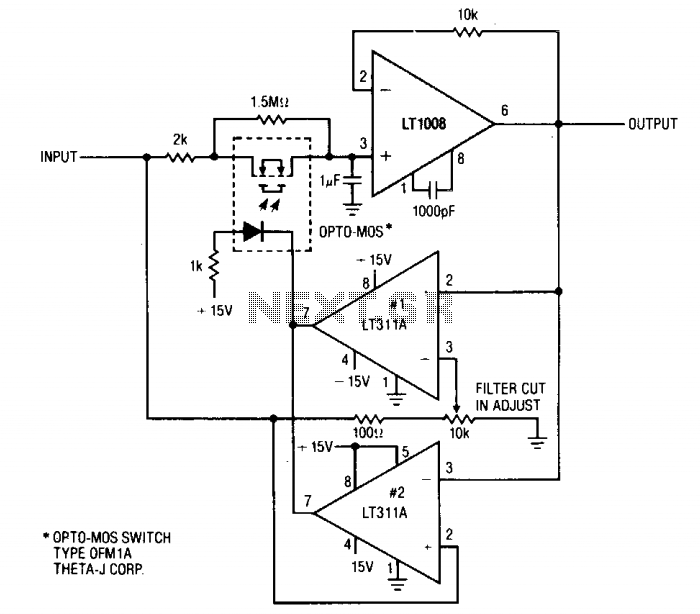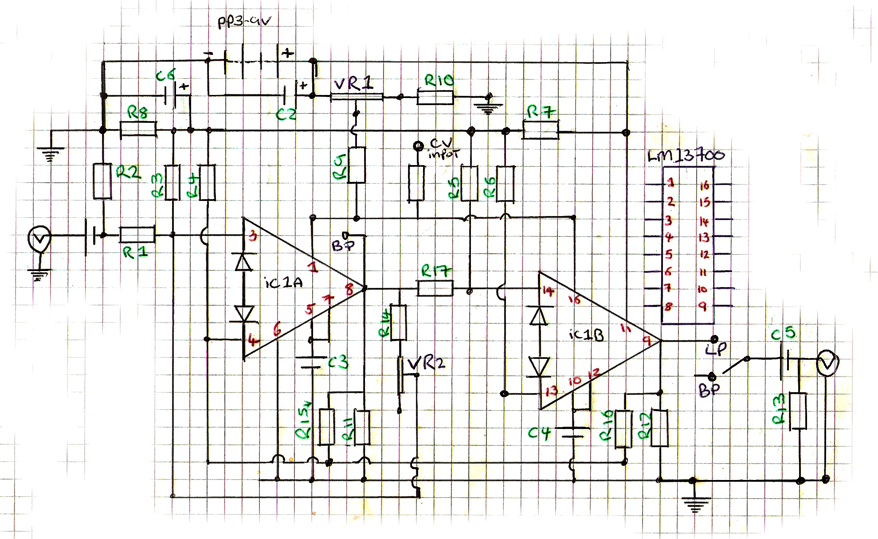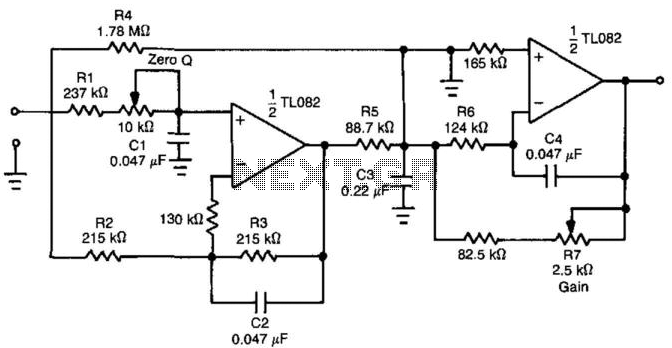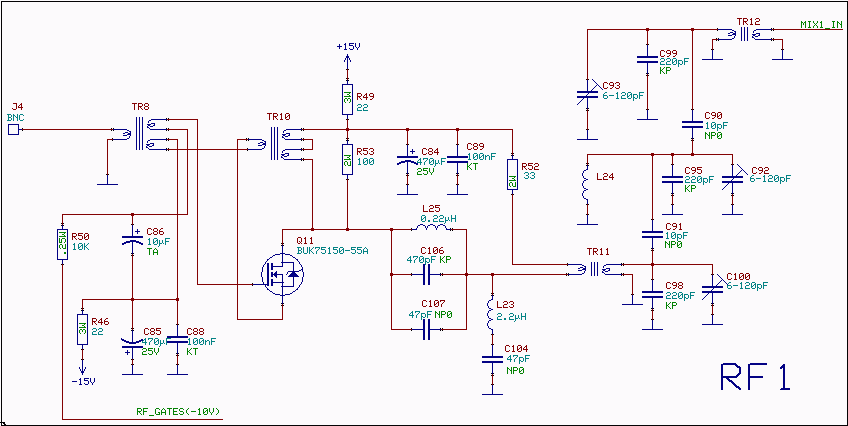
Subwoofer filter

The circuit diagram illustrates an operational amplifier (op-amp) based subwoofer filter. Audio frequencies below 200 Hz are classified as subwoofer frequencies, thus the subwoofer filter functions as a low-pass filter with a cutoff frequency of 200 Hz. The operation of this straightforward circuit is as follows: the left channel of the audio source connects to the non-inverting input of op-amp U1, which is configured as a buffer. Op-amps U2 and U3 create a high-pass filter, with the output of U1 feeding into this filter. The high-pass filtered audio signal at the output of U3 represents the left channel output. Similarly, the right channel of the audio source connects to the non-inverting input of op-amp U8, which is also configured as a buffer amplifier. The output of U8 connects to the input of the high-pass filter formed by op-amps U9 and U10, producing the right channel audio output at the output of U10. The outputs of U1 and U8 are connected to the inverting input of op-amp U4, which mixes the two signals. The output from U4 is then connected to a low-pass filter composed of op-amps U5 and U6, with a cutoff frequency of 200 Hz. The output of this filter is connected to the inverting input of op-amp U7 via potentiometer R22. U7 operates as an output amplifier, and the gain can be adjusted using potentiometer R22. The audio signal available at the output of U7 serves as the subwoofer output. Some capacitor values indicated in the circuit may be difficult to source commercially; a practical solution is to combine available capacitors in series or parallel to achieve the desired capacitance.
The circuit employs a series of operational amplifiers to create an effective audio processing system tailored for subwoofer applications. The use of op-amp U1 as a buffer ensures that the input audio signal maintains its integrity without loading the source, allowing for accurate signal transmission to the subsequent high-pass filter stages. This is critical in preserving the quality of the audio signal, particularly for the left channel.
The high-pass filter configuration formed by op-amps U2 and U3 is designed to eliminate frequencies below the desired cutoff, effectively allowing only those above a certain threshold to pass through. This is particularly useful in subwoofer applications where low-frequency signals need to be filtered out to prevent distortion and to optimize the performance of the subwoofer.
For the right channel, the same buffering and filtering principles apply, with op-amp U8 serving as a buffer for the right channel audio source. The high-pass filter created by op-amps U9 and U10 mirrors the design of the left channel filter, ensuring that the right channel audio signal is also appropriately processed.
The mixing of the left and right channel signals occurs at op-amp U4, which combines the outputs from U1 and U8, enabling a coherent stereo output for the subwoofer. The subsequent low-pass filter, constructed from op-amps U5 and U6, is crucial for allowing only the low-frequency components of the mixed signal to pass through, effectively defining the subwoofer's operating range.
The gain adjustment feature implemented through potentiometer R22 connected to op-amp U7 allows for fine-tuning of the output level, providing flexibility to match the subwoofer output with other components in the audio system. This capability is essential for achieving optimal sound levels and integration within a larger audio setup.
In summary, this op-amp based subwoofer filter circuit provides a comprehensive solution for processing audio signals intended for low-frequency reproduction, ensuring high fidelity and performance in subwoofer applications while allowing for adjustments and modifications based on component availability.Here is the circuit diagram of an opamp based subwoofer filter. Audio frequencies below 200Hz are considered to be in the subwoofer range. So a subwoofer filter will be essentially a low pass filter with a cut off frequency of 200Hz. The working of this straight forward circuit is as follows. The left channel of the audio source is connected to the non-inverting input of opamp U1 which is wired as a buffer. Opamps U2 and U3 forms a high pass filter. Output of U1 is coupled the input of this high pass filter. The high pass filtered audio signal available at the output of U3 represents left channel output. Similarly the right channel of the audio source is connected to the non-inverting input of U8 which wired as a buffer amplifier. The output of U8 is connected to the input of the high pass filter formed by opamps U9 and U10. The filtered audio signal available at the output of U10 represents the right channel audio output. Output of U1 and U8 are coupled to the inverting input of the opamp U4. U4 performs the job of mixing the two signals. Output of U4 is coupled to the input of the low pass filter comprising of opamps U5 and U6. The low pass filter has a cut off frequency of 200Hz. The output of the filter is coupled to the inverting input of opamp U7 through the POT R22. U7 works as an output amplifier and POT R22 can be used for adjusting the gain. The audio signal available at the output of U7 represents the subwoofer output. Some capacitance values shown in the circuit are hard to find in the market. The best solution is to combine available capacitors serially or parallely to obtain the required value.
🔗 External reference
The circuit employs a series of operational amplifiers to create an effective audio processing system tailored for subwoofer applications. The use of op-amp U1 as a buffer ensures that the input audio signal maintains its integrity without loading the source, allowing for accurate signal transmission to the subsequent high-pass filter stages. This is critical in preserving the quality of the audio signal, particularly for the left channel.
The high-pass filter configuration formed by op-amps U2 and U3 is designed to eliminate frequencies below the desired cutoff, effectively allowing only those above a certain threshold to pass through. This is particularly useful in subwoofer applications where low-frequency signals need to be filtered out to prevent distortion and to optimize the performance of the subwoofer.
For the right channel, the same buffering and filtering principles apply, with op-amp U8 serving as a buffer for the right channel audio source. The high-pass filter created by op-amps U9 and U10 mirrors the design of the left channel filter, ensuring that the right channel audio signal is also appropriately processed.
The mixing of the left and right channel signals occurs at op-amp U4, which combines the outputs from U1 and U8, enabling a coherent stereo output for the subwoofer. The subsequent low-pass filter, constructed from op-amps U5 and U6, is crucial for allowing only the low-frequency components of the mixed signal to pass through, effectively defining the subwoofer's operating range.
The gain adjustment feature implemented through potentiometer R22 connected to op-amp U7 allows for fine-tuning of the output level, providing flexibility to match the subwoofer output with other components in the audio system. This capability is essential for achieving optimal sound levels and integration within a larger audio setup.
In summary, this op-amp based subwoofer filter circuit provides a comprehensive solution for processing audio signals intended for low-frequency reproduction, ensuring high fidelity and performance in subwoofer applications while allowing for adjustments and modifications based on component availability.Here is the circuit diagram of an opamp based subwoofer filter. Audio frequencies below 200Hz are considered to be in the subwoofer range. So a subwoofer filter will be essentially a low pass filter with a cut off frequency of 200Hz. The working of this straight forward circuit is as follows. The left channel of the audio source is connected to the non-inverting input of opamp U1 which is wired as a buffer. Opamps U2 and U3 forms a high pass filter. Output of U1 is coupled the input of this high pass filter. The high pass filtered audio signal available at the output of U3 represents left channel output. Similarly the right channel of the audio source is connected to the non-inverting input of U8 which wired as a buffer amplifier. The output of U8 is connected to the input of the high pass filter formed by opamps U9 and U10. The filtered audio signal available at the output of U10 represents the right channel audio output. Output of U1 and U8 are coupled to the inverting input of the opamp U4. U4 performs the job of mixing the two signals. Output of U4 is coupled to the input of the low pass filter comprising of opamps U5 and U6. The low pass filter has a cut off frequency of 200Hz. The output of the filter is coupled to the inverting input of opamp U7 through the POT R22. U7 works as an output amplifier and POT R22 can be used for adjusting the gain. The audio signal available at the output of U7 represents the subwoofer output. Some capacitance values shown in the circuit are hard to find in the market. The best solution is to combine available capacitors serially or parallely to obtain the required value.
🔗 External reference





